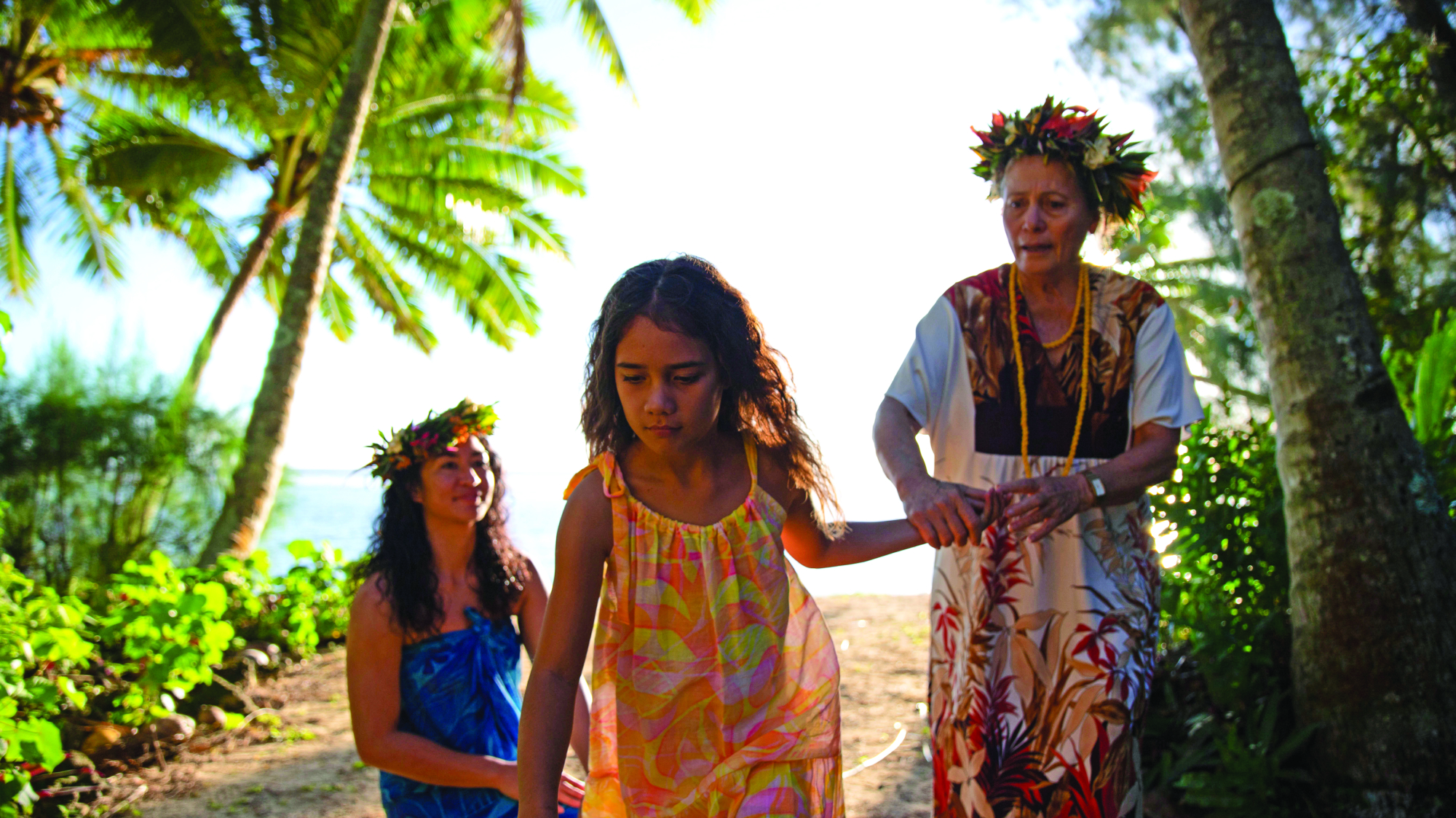We sweat and cry salt water, so we know
that the ocean is really in our blood.
—Teresia Teaiwa[1]Teresia Teaiwa, quoted in Epeli Hau‘ofa, ‘The Ocean in Us’, The Contemporary Pacific, vol. 10, no. 2, Fall 1998, p. 392.
A spiritual sequel to the anthology film Waru (2017), Vai (2019) – the second feature-length release from Brown Sugar Apple Grunt Productions – enlists eight female writer/directors from eight Pacific Island nations to make a portmanteau film about the latter titular character. The languages of the Pacific aren’t always mutually intelligible, but they retain certain shared words; ‘vai’ (‘water’) is a key example. This is undoubtedly a result of Islander cultures having been shaped, in fundamental ways, by the largest body of water on Earth; the Pacific Ocean flows through our creation stories, sustains our agricultural practices, is filled with life and is seen to give life. In a manner similar to Waru, Vai is loosely tied together by an overarching narrative but is divided into eight ten-minute chapters, each focusing on a different moment in Vai’s life, on a different island. Each chapter is also largely shot in one take – a stylistic decision that is political as much as it was economical, facilitating a tighter shooting schedule and ensuring that no edits could be made to the chapters down the track, thereby preserving each creator’s vision.[2]See James Croot, ‘Waru Follow-up Debuting at Berlin Film Festival This Weekend’, Stuff.co.nz, 10 February 2019, <https://www.stuff.co.nz/entertainment/film/110385427/vai-waru-followup-to-debut-at-berlin-film-festival>, accessed 12 August 2019. Given that all island(er)s see the ocean from different vantage points, it’s only apposite that the cultural legacies that empower Vai in each vignette likewise take different forms.
The film begins in Fiji, with Vai’s story told through seven-year-old Sevaia (Mereani Tuimatanisiga). Nicole Whippy’s chapter (co-written with sister Sharon) shows Sevaia playing with her friends, wandering through her home and protesting her family’s pending emigration to Aotearoa (New Zealand). The vignette climaxes when Sevaia’s grandmother joins the chorus of protest and begs her daughter to let Sevaia stay with her, reminding me of my own (Fijian) grandmother’s reaction when my mother announced that she would be raising us in Perth. The three generations of women then begin crying together – and this theme of inevitable loss and eventual return echoes throughout the film. Limited resources and infrastructure have meant that many Pacific Islander families, or fragments of families, move to Australia or Aotearoa and subsequently send remittances to family members back home.[3]See Nic Maclellan & Peter Mares, ‘Remittances and Pacific Development’, in ‘Labour Mobility in the Pacific: Creating Seasonal Work Programs in Australia’, in Stewart Firth (ed.), Globalisation and Governance in the Pacific Islands, ANU E Press, Canberra, 2006, pp. 137–72, available at <http://press-files.anu.edu.au/downloads/press/p55871/html/ch08s02.html>, accessed 6 August 2019 The grandmother consoles Sevaia by saying, ‘We will always be together. I will never leave you’ – a statement subtly evoking a pre-colonial cosmology that challenges Western understandings of time and space, and within which a child’s ancestors are always connected to them. The chapter concludes with an image of Sevaia dancing in the rain.
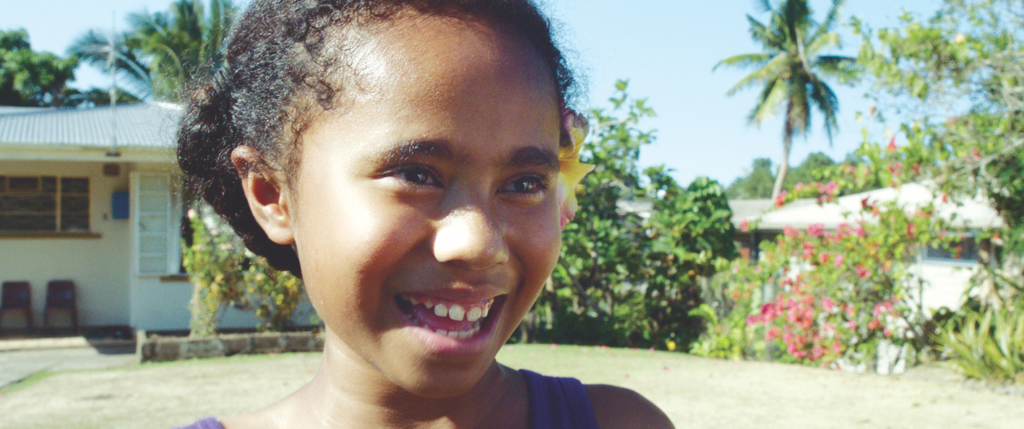
The second incarnation of Vai, in the segment written and directed by ‘Ofa-Ki-Levuka Guttenbeil-Likiliki, is thirteen-year-old Vai Mo‘ui (‘Ar-Ramadi Longopoa), who lives in the Kingdom of Tonga. Mounting oceanic temperatures deprive Tongans of much-needed rain, and it is the search for water that drives this vignette. Here, Vai’s grandmother is a kau faito‘o: a practitioner of traditional medicine. The kau faito‘o don’t charge for their services, as their skill is seen as a gift from God and to accept payment for it would be shameful;[4]To learn more about the figure of the kau faito‘o, see the documentary Kau Faito‘o: Traditional Healers of Tonga (Melinda Ostraff, 2001). this is the first of many counter-capitalist tendencies dramatised in the film. Later, the grandmother is shown making a remedy for someone in Aotearoa that requires water; she sends Vai and her brother to fetch some, and their search leads them to a mysterious stranger draped in purple. The stranger states that she will give them water if Vai sings her a song, and, as Vai obliges her, the stranger removes her shawl and reveals herself to be Indira Moala Stewart, the Tongan/Fijian runner-up of the 2006 edition of New Zealand Idol. The stunned Vai asks if she can learn to sing like her, to which Indira says no. As Tongan custom stipulates that you must never imitate those whom you respect,[5]See Paul Theroux, ‘In the Court of the King of Tonga’, The New York Times, 7 June 1992, <https://www.nytimes.com/1992/06/07/magazine/in-the-court-of-the-king-of-tonga.html>, accessed 6 August 2019. Indira offers to teach Vai to use her own voice instead.
First Nations peoples’ advocacy for living in harmony with nature is contrasted with the white world order’s insistence on conquering it … the economical and the ecological are co-dependent.
At the border of allegory and the imagination, we see sixteen-year-old Vaelusa (Betsy Luitolo) fishing off the coast of the Solomon Islands. Shot in its entirety on/in the sea, Matasila Freshwater’s chapter depicts the angry teenager imagining a confrontation with her mother, who is sailing in a canoe beside hers. The conversation reveals that Vaelusa has the potential for an overseas scholarship, but a defeatist attitude stemming from an immense pain from her past has made her ambivalent. Vaelusa also resents her mother, feeling abandoned by the latter’s move to Aotearoa ten years prior. The undercurrent of loss and sacrifice introduced in the first chapter likewise permeates this vignette, which navigates the spaces between mother and daughter,[6]Freshwater has described her mother as her anchor and an orator of stories that connected her to her community and culture; see Lana Lopesi, ‘Moving On from Disney’s Moana: The Broader Portrayal of Women in Vai’, The Pantograph Punch, 4 April 2019, <https://www.pantograph-punch.com/post/the-broader-portrayal-of-women-in-vai>, accessed 6 August 2019. adolescence and adulthood, anger and acceptance. Vaelusa is faced with a choice: to wallow, or to commit to trying to improve her quality of life. She wakes up, literally and figuratively, after diving into the ocean to return her anchor to her canoe.
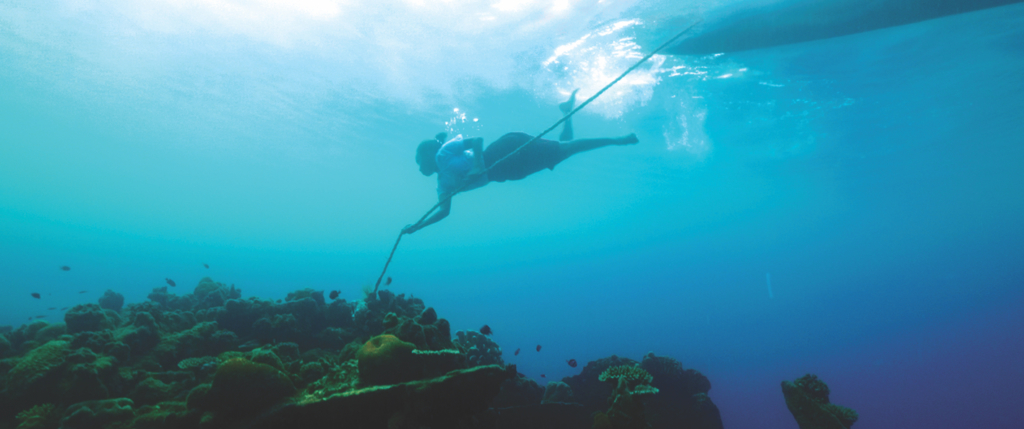
In Amberley Jo Aumua’s chapter, twentysomething Aotearoa-born Samoan Vaisea (Agnes Pele) has earned her place at a university in Auckland. However, her prospects are somewhat compromised by institutions that were not designed to accommodate her. Financially supporting her family (in Aotearoa and Samoa) makes her late for class; phone calls from landlords, kin and colleagues constantly distract her; and her friends expect her to be present physically and emotionally. All the while, Vaisea’s tutor refuses to acknowledge why she may be feeling overwhelmed. The harsh realities of Vaisea’s situation are compounded by the fact that, in Aotearoa, First Nations women make less money than their male and non–First Nations counterparts: in 2018, household economic data revealed that pakeha (New Zealander of European descent) men earn an average of NZ$33.59 an hour; pakeha women, NZ$28.38; Maori women, NZ$24.26; and Pacific Islander women, NZ$23.01.[7]Tamsyn Parker, ‘Mind the Gap: Money Hurdles for Women Remain’, The New Zealand Herald, 10 September 2018, <https://www.nzherald.co.nz/personal-finance/news/article.cfm?c_id=12&objectid=12118282>, accessed 7 August 2019. But the narrative’s focal point isn’t money – it’s family. While Vaisea is scolded by her tutor for prioritising family over study, it’s because of her family that she can study, and her ongoing commitment to them is inextricable from the continued sewing of her identity. One is not easily, and rarely willingly, extricated from that fabric.
Aumua’s chapter is the only one in which Vai comes into conflict with, rather than finding strength from, her environment. It’s also the only vignette that doesn’t feature water. Cut to Kūki ‘Āirani (the Cook Islands), where Mīria George’s Vai (Evotia-Rose Araiti) is now thirty years old. Initially submerged in the sea, Vai emerges and is adorned by her grandmother with an ‘ei: a floral headdress that channels the living essence of the island and draws on tapu, which designates something sacred that comes with rules.[8]For more on the ‘ei, see Tales of Taonga – the Kuki Airani Church Hats (Jessica Sanderson, 2019), available at <https://www.thecoconet.tv/know-your-roots/im:13217/tales-of-taonga-the-kuki-airani-church-hats/>. ‘Tapu’ is also the etymological root of the English word ‘taboo’; see ‘Taboo (Adj.)’, Online Etymology Dictionary, <https://www.etymonline.com/word/taboo>, both accessed 7 August 2019. Vai proceeds to protest against unsafe and exploitative fishing practices, thereby setting an example that her daughter, Mata (Teau Goldsworthy) – whose name is Māori Kūki ‘Āirani for ‘eye’ – will witness. Tapu is relevant to fishing, as priests and chiefs have historically declared resources tapu for periods of time to prevent overfishing. Here, First Nations peoples’ advocacy for living in harmony with nature is contrasted with the white world order’s insistence on conquering it. When Vai confronts the fishermen, she embodies the wrath of an ocean in a tempest because she understands that the economical and the ecological are co-dependent. One cannot be exchanged for the other.
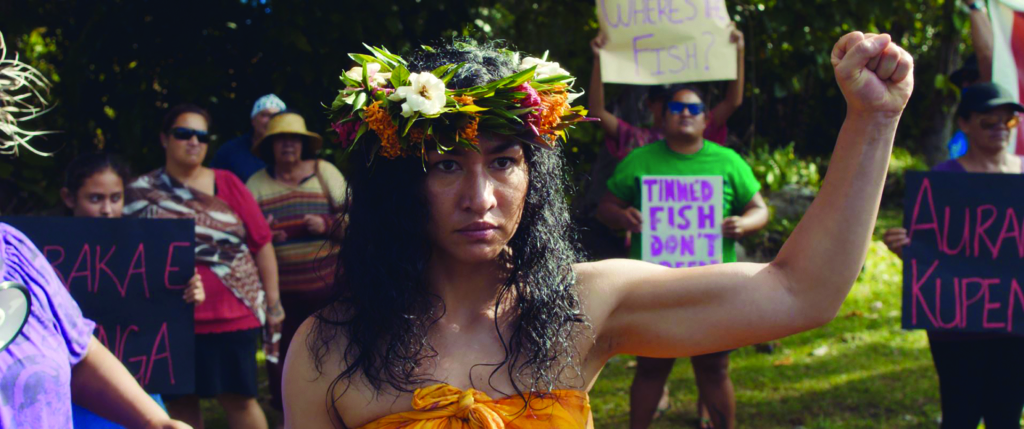
Shifting our focus to Samoa, the film introduces us to Sevai (Fiona Collins), who is less sure of herself. The 42-year-old is expected to lead an ‘ailao afi: a ceremonial parade through which a leader demonstrates their physical prowess by twirling, throwing and catching a nifo‘oti (a Samoan war club, similar to a machete).[9]Mike Foley, ‘Pulefano Galea‘i: The History of PCC’s Special Event and Samoan Knife Dancing’, Polynesian Cultural Center website, 6 May 2016, <https://www.polynesia.com/blog/pulefano-galeai-the-history-of-pccs-special-event-and-samoan-knife-dancing/>, accessed 12 August 2019. The blade remains sharp, in accordance with custom, but it’s not the knife that makes Sevai anxious. Her malaise stems from the fear of not being Samoan enough to represent and lead others in her community. Mixed heritages and time abroad are standard side effects of globalisation, as is the insecurity that one doesn’t belong in either of one’s parents’ worlds. What could be called ‘transcendental solidarity’ – dramatised here by the presence of ancestors past and present – is what gives Sevai the strength to move forward. Mirroring director Marina Alofagia McCartney’s own aunty’s advice,[10]Marina Alofagia McCartney, quoted in Lopesi, op. cit. the character of Aunty Pepe (Ana Tuigamala) states that Sevai’s fa‘a Sāmoa (‘Samoan way’) is ‘in [her] bones’ – it’s materialised in her ula nifo (necklace) made of bones and teeth, and embedded in her soul.
But Vai’s story isn’t linear; it’s circular. In Dianna Fuemana’s chapter, as waves crash on the shores of Niue, Moana (Sariah Magaoa) tells her grandmother Vai (Maliaga Erick) that she doesn’t want to move to Aotearoa. Moana sidesteps her huki teliga (ear-piercing coming-of-age ceremony[11]‘Country Profile – Niue’, Pacific Trade Invest Australia website, 18 October 2018, <https://pacifictradeinvest.com/explore-our-work/insights/country-profile-niue>, accessed 6 August 2019.) to see a girl, Olivia (Janelle Toatapu). The elusive hug they share, coupled with their reluctance to let go, suggests that they may be lovers. Vai approaches the young women, feigns a heart attack, then reveals that she’s joking – a canny gesture in the context of the socially conservative, very religious Pacific region (homosexuality is currently illegal in Tonga, Samoa, and the Cook and Solomon islands, among others[12]These policies are remnants of British colonisation; see Harriet Smith, ‘Australia’s Marriage-equality Debate Reverberates Through the Pacific’, The Interpreter, Lowy Institute, 31 October 2016, <https://www.lowyinstitute.org/the-interpreter/australias-marriage-equality-debate-reverberates-through-pacific>, accessed 6 August 2019.). With Olivia then shown leading a tamē (dance) despite her affections for Moana, Fuemana is suggesting that we can honour our past without being trapped within it.
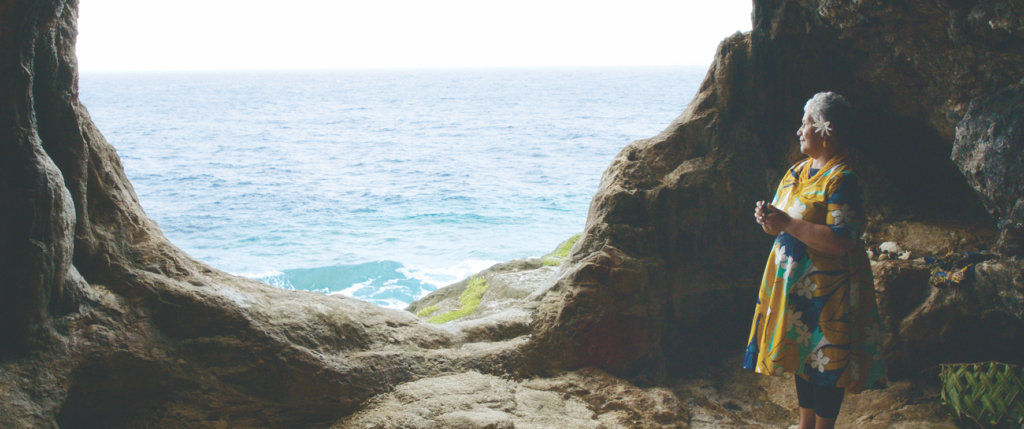
Lastly, in Aotearoa, Becs Arahanga’s eighty-year-old version of Vai, Rapuwai (Hinetu Dell), is now a great-grandmother; the film closes with a Maori baptism of lesbian couple Moana (Kasina Campbell) and Hinewai’s (Waimihi Hotere) baby. In Maori theology, Hineahuone and Hinetitama were the first women. When Hinetitama discovered that her husband was her father, she became so ashamed that she transformed into Hinenuitepō and assumed custodianship of the threshold between night and day, darkness and light. Maori people see themselves as Hinenuitepō’s children, and believe that, when they die, they journey to their hawaiki (ancient homeland) and return to Hinenuitepō’s womb in the afterlife.[13]See ‘Diane Tatana Storytelling About Hine-Ahu-One’, YouTube, 20 August 2012, <https://www.youtube.com/watch?v=3moDkFASeIg>; and Wiremu Grace, ‘A Trilogy of Wahine Toa’, in ‘Māori Myths, Legends and Contemporary Stories’, Ministry of Education, New Zealand Government, <http://eng.mataurangamaori.tki.org.nz/Support-materials/Te-Reo-Maori/Maori-Myths-Legends-and-Contemporary-Stories/A-trilogy-of-Wahine-Toa>, both accessed 7 August 2019. In the film, the baptism takes place in the Riuwaka River valley, the landing place of their iwi (tribal) ancestors when they came from Te moana nui a Kiwa (the Pacific Ocean). Rapuwai’s karakia (prayer) calls on Hineahuone, Hinetitama and Hinenuitepō to bless the child, and the chapter concludes with Rapuwai saying, ‘Always return to this place which nurtures you, and I will be beside you. You are the water, and the water is you.’
As Islanders, we feel the ocean within us; it’s around us, and it connects us. In a similar vein, Vai represents both an individual and a community: she is the Whippy sisters, Guttenbeil-Likiliki, Freshwater, Aumua, George, McCartney, Fuemana and Arahanga, existing in and through all of them, and continuing to exist once they leave this realm. Each reincarnation of this figure reinforces the timelessness and resilience of Pacific Islander women; as McCartney puts it:
This way of making films taps into the collective nature of our cultures […] We are multilayered people and can tell stories in multilayered ways, including having multilayered narratives […] We’re more than the sum of our own parts. When you work as a collective or as a community, the project just becomes bigger and stronger than any of our own weaknesses. I think it’s just a great example of what can happen when Māori and Pacific women get together.[14]McCartney, quoted in Lopesi, op. cit.
Endnotes
| 1 | Teresia Teaiwa, quoted in Epeli Hau‘ofa, ‘The Ocean in Us’, The Contemporary Pacific, vol. 10, no. 2, Fall 1998, p. 392. |
|---|---|
| 2 | See James Croot, ‘Waru Follow-up Debuting at Berlin Film Festival This Weekend’, Stuff.co.nz, 10 February 2019, <https://www.stuff.co.nz/entertainment/film/110385427/vai-waru-followup-to-debut-at-berlin-film-festival>, accessed 12 August 2019. |
| 3 | See Nic Maclellan & Peter Mares, ‘Remittances and Pacific Development’, in ‘Labour Mobility in the Pacific: Creating Seasonal Work Programs in Australia’, in Stewart Firth (ed.), Globalisation and Governance in the Pacific Islands, ANU E Press, Canberra, 2006, pp. 137–72, available at <http://press-files.anu.edu.au/downloads/press/p55871/html/ch08s02.html>, accessed 6 August 2019 |
| 4 | To learn more about the figure of the kau faito‘o, see the documentary Kau Faito‘o: Traditional Healers of Tonga (Melinda Ostraff, 2001). |
| 5 | See Paul Theroux, ‘In the Court of the King of Tonga’, The New York Times, 7 June 1992, <https://www.nytimes.com/1992/06/07/magazine/in-the-court-of-the-king-of-tonga.html>, accessed 6 August 2019. |
| 6 | Freshwater has described her mother as her anchor and an orator of stories that connected her to her community and culture; see Lana Lopesi, ‘Moving On from Disney’s Moana: The Broader Portrayal of Women in Vai’, The Pantograph Punch, 4 April 2019, <https://www.pantograph-punch.com/post/the-broader-portrayal-of-women-in-vai>, accessed 6 August 2019. |
| 7 | Tamsyn Parker, ‘Mind the Gap: Money Hurdles for Women Remain’, The New Zealand Herald, 10 September 2018, <https://www.nzherald.co.nz/personal-finance/news/article.cfm?c_id=12&objectid=12118282>, accessed 7 August 2019. |
| 8 | For more on the ‘ei, see Tales of Taonga – the Kuki Airani Church Hats (Jessica Sanderson, 2019), available at <https://www.thecoconet.tv/know-your-roots/im:13217/tales-of-taonga-the-kuki-airani-church-hats/>. ‘Tapu’ is also the etymological root of the English word ‘taboo’; see ‘Taboo (Adj.)’, Online Etymology Dictionary, <https://www.etymonline.com/word/taboo>, both accessed 7 August 2019. |
| 9 | Mike Foley, ‘Pulefano Galea‘i: The History of PCC’s Special Event and Samoan Knife Dancing’, Polynesian Cultural Center website, 6 May 2016, <https://www.polynesia.com/blog/pulefano-galeai-the-history-of-pccs-special-event-and-samoan-knife-dancing/>, accessed 12 August 2019. |
| 10 | Marina Alofagia McCartney, quoted in Lopesi, op. cit. |
| 11 | ‘Country Profile – Niue’, Pacific Trade Invest Australia website, 18 October 2018, <https://pacifictradeinvest.com/explore-our-work/insights/country-profile-niue>, accessed 6 August 2019. |
| 12 | These policies are remnants of British colonisation; see Harriet Smith, ‘Australia’s Marriage-equality Debate Reverberates Through the Pacific’, The Interpreter, Lowy Institute, 31 October 2016, <https://www.lowyinstitute.org/the-interpreter/australias-marriage-equality-debate-reverberates-through-pacific>, accessed 6 August 2019. |
| 13 | See ‘Diane Tatana Storytelling About Hine-Ahu-One’, YouTube, 20 August 2012, <https://www.youtube.com/watch?v=3moDkFASeIg>; and Wiremu Grace, ‘A Trilogy of Wahine Toa’, in ‘Māori Myths, Legends and Contemporary Stories’, Ministry of Education, New Zealand Government, <http://eng.mataurangamaori.tki.org.nz/Support-materials/Te-Reo-Maori/Maori-Myths-Legends-and-Contemporary-Stories/A-trilogy-of-Wahine-Toa>, both accessed 7 August 2019. |
| 14 | McCartney, quoted in Lopesi, op. cit. |
